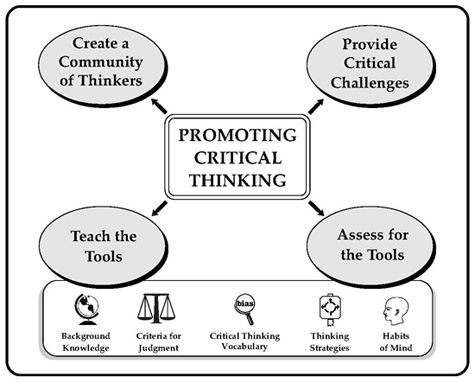Question 4 – What activities will enable students to learn?
Part of teachers’ professional responsibilities involves translating learner outcomes into meaningful learning activities (see Alberta Education Directive 4.2.1. in bibliography). Wiggins and McTighe caution teachers against the danger of merely "covering" the curriculum and suggest instead that the teachers’ goal is to help students "uncover" and discover the curriculum. The Critical Thinking Consortium (TC2) maintain that the uncovering of curriculum occurs only when students investigate purposeful questions that present meaningful problems or challenges to address. Even well planned, interesting, colourful and relevant learning activities can fail to involve students in thinking meaningfully about the ideas.
Simply asking students to think will not yield critically thoughtful students. Planned, purposeful instruction is needed to provide students with the intellectual tools they need to think critically. Background Knowledge, Criteria for Judgement, Critical Thinking Vocabulary, Thinking Strategies and Habits of Mind are powerful means to scaffold student learning and guide students as they interact with the content of the curriculum.
Figure 2 represents the foundational role the intellectual tools play in promoting critical thinking.

Figure 2: Promoting Critical Thinking © The Critical Thinking Consortium (TC2)
Background Knowledge is essential in order for critical thinking to occur. Students require information on which to base their reasoning, judgements, decisions, and so forth. Critical thinking instruction is best achieved when embedded within authentic curricular content. The content of the program of studies can be taught in a more meaningful way when taught through the skills of critical thinking. Both content and skills are important.
Criteria for Judgement form the basis for making reasoned judgement. This intellectual tool has broad application. People use criteria when making decisions on a daily basis from what to wear given the weather and the day’s activities; what to eat based on what is available, dietary restrictions and personal preferences; how to spend leisure time; and other decisions ranging from trivial to important. What moves these kinds of low-level responses into the realm of critical thinking is the awareness that is brought to the decision-making process; that is, being aware of the criteria and applying them thoughtfully.
Teachers use criteria when translating learner outcomes into meaningful learning activities. When planning instruction, they decide what’s important and identify the evidence they need to determine that learning has occurred. Inviting students into the assessment conversation deepens student understanding of the learning goals and increases the opportunity for success.
Critical Thinking Vocabulary refers to essential concepts and distinctions that are needed to process information in a critically thoughtful manner. Examples of such concepts within the social studies learner outcomes include:
- support and conclusion
- cause and effect
- evidence and inference
- bias and objectivity
- validity and reliability
- fact and opinion
These complex concepts require specific instruction, ongoing modelling and labelling before they become part of a student’s repertoire of critical thinking skills.
Thinking Strategies are used extensively when working through challenges and problems. They become part of a personal bank of strategies to draw on during problematic situations. Part of learning to think critically is to be aware of the strategies and make purposeful decisions as to which strategy will best achieve the goals of the particular challenge based on reasoned judgement. Thinking strategies embedded within the social studies learner outcomes include use and development of decision-making models; use of graphic organizers; application of inquiry models; and communication skills such as note-taking, media literacy and presentation skills.
Habits of Mind are personal qualities that facilitate good thinking. They are commitments to the range of values and principles of a careful and conscientious thinker, such as being open-minded, fair-minded, accepting and reflective. These intellectual tools are often taught incidentally; critical thinking requires purposeful teaching of these habits of mind, with opportunities to use and reflect on them, planned into the instructional sequence.
The intellectual tools provide opportunities for students to interact with the content of the program of studies in meaningful ways. Critical thinking is a methodology that is infused throughout the curriculum. It can and should happen in virtually every context of learning – from reading to note taking to complex project work.
Critically thoughtful learners are metacognitive. They think about their learning and can articulate what quality looks like. They are developing the habits of mind that allow them to recognize the value of formative feedback. They see purpose and value in their work.
|







